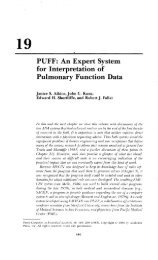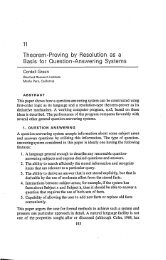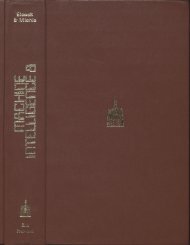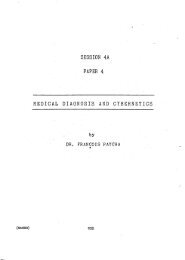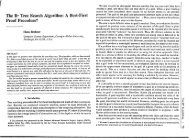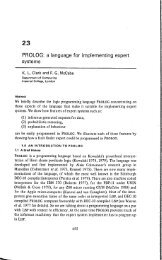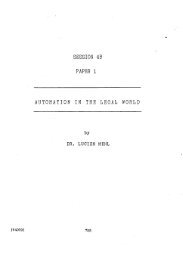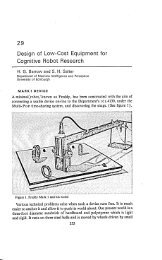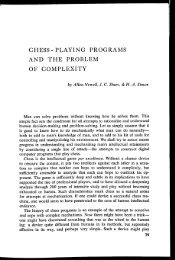8 Paramodulation and Theorem-proving in First-Order ... - AITopics
8 Paramodulation and Theorem-proving in First-Order ... - AITopics
8 Paramodulation and Theorem-proving in First-Order ... - AITopics
Create successful ePaper yourself
Turn your PDF publications into a flip-book with our unique Google optimized e-Paper software.
8<strong>Paramodulation</strong> <strong>and</strong> <strong>Theorem</strong>-<strong>prov<strong>in</strong>g</strong><strong>in</strong> <strong>First</strong>-<strong>Order</strong> Theories with EqualityG. Rob<strong>in</strong>sonStanford L<strong>in</strong>ear Accelerator CenterStanford, California<strong>and</strong>L. WosArgonne National LaboratoryArgonne, Ill<strong>in</strong>oisINTRODUCTIONA term is an <strong>in</strong>dividual constant or variable or an n-adic function letterfollowed by n terms. An atomic formula is an n-adic predicate letter followedby n terms. A literal is an atomic formula or the negation thereof. A clauseis a set of literals <strong>and</strong> is thought of as represent<strong>in</strong>g the universally-quantifieddisjunction of its members. It will sometimes be notationally convenientl todist<strong>in</strong>guish between the empty clause 0, viewed as a clause, <strong>and</strong> 'other'empty sets such as the empty set of clauses, even though all these empty setsare the same set-theoretic object 4). A ground clause (term, literal) is one withno variables. A clause C' (literal, term) is an <strong>in</strong>stance of another clause C(literal, term) if there is a uniform replacement of the variables <strong>in</strong> C byterms that transform C <strong>in</strong>to C'.The Herbr<strong>and</strong> universe Hs of a set S of clauses is the set of all terms thatcan be formed from the function letters <strong>and</strong> <strong>in</strong>dividual constants occurr<strong>in</strong>g<strong>in</strong> S (with the proviso that if S conta<strong>in</strong>s no <strong>in</strong>dividual constant, the constanta is used). An <strong>in</strong>terpretation I of a set S of clauses is a set of ground literalssuch that for each atomic formula F that can be formed from an n-adicpredicate letter occurr<strong>in</strong>g <strong>in</strong> S <strong>and</strong> n terms from Hs, exactly one of theliterals F or F (the negation of F) is <strong>in</strong> I.For any set.! of literals, .7 is the set of negations of members of.!. The set Jsatisfies a ground clause C if ./nCO ck <strong>and</strong> condemns Cif C — J = J satisfiesa non-ground clause C if it satisfies every <strong>in</strong>stance of C <strong>and</strong> condemns C if itcondemns some <strong>in</strong>stance of C. A clause (possibly ground) that is neither1 Note, for example, that the empty set is a satisfiable set of clauses but at the same timeis an unsatisfiable clause.135
THEOREM PROVINGsatisfied nor condemned by J is said to be undef<strong>in</strong>ed for J; otherwise it isdef<strong>in</strong>ed for .1. .1 satisfies a set S of clauses if it satisfies every clause <strong>in</strong> S <strong>and</strong>condemns S if it condemns some clause <strong>in</strong> S.An R-Interpretation of a set S of clauses is an <strong>in</strong>terpretation / of S hav<strong>in</strong>gthe follow<strong>in</strong>g properties: Let a, [3, <strong>and</strong> y be any terms <strong>in</strong> Ifs <strong>and</strong> L any literal<strong>in</strong> I. Then1. (a=a)e/2. If (a= )3) e /then (I3=a) e /3. If (a=p)e /<strong>and</strong> (13=y) L then (a=y) e L4. If L' is the result of replac<strong>in</strong>g some one occurrence of a <strong>in</strong> L by ,6 <strong>and</strong>(a =/3) e /, then L' EI.An (R-)model of S is an (R-)<strong>in</strong>terpretation of S that satisfies S.A set S of clauses is (R-)satisfiable if there is an (R-)model of S; otherwise itis (R-)unsatisfiable.If S is a set of clauses or a s<strong>in</strong>gle clause <strong>and</strong> Tis a set of clauses or a s<strong>in</strong>gleclause, S(R-)implies T(abbreviation SW' or SRT)if no (R-)model of Scondemns 7'.A deductive system W is (R-)deduction-complete if SI- wT(T is deduciblefrom S <strong>in</strong> the system W) whenever SW' (SkRT). W is (R-)refutationcompleteif SI- wEl whenever S is (R-)unsatisfiable.EQUALITY IN AUTOMATIC THEOREM-PROVINGThe methods for deal<strong>in</strong>g with the concept of equality <strong>in</strong> theorem-<strong>prov<strong>in</strong>g</strong> canbe grouped roughly <strong>in</strong>to three classes: (1) those which employ a set of firstorderaxioms for equality, for example, the follow<strong>in</strong>g set (which we shall callE(K), where K is the set of first-order sentences under study):(i) (xi) (xi =xi)(ii)(j= 1, . . n)(xi) • • • (x.)(xo)(xj0 xo V i(xi • • • xi • • • xn)=f(xi xo x.))(j= 1, n)where n axioms of the form (ii) are <strong>in</strong>cluded for each n-adic (n >0) predicateletter P occurr<strong>in</strong>g <strong>in</strong> K, <strong>and</strong> n axioms of the form (iii) are <strong>in</strong>cluded for eachn-adic (n >0) function letter <strong>in</strong> K'; (2) those which employ a smaller set ofsecond-order axioms for equality; <strong>and</strong> (3) those which employ a substitutionrule for equals as a rule of <strong>in</strong>ference.SOME DESIRABLE PROPERTIES FOR THEOREM-PROVINGALGORITHMSIn addition to the logical properties of soundness <strong>and</strong> completeness, two setsof somewhat more elusive properties are of <strong>in</strong>terest <strong>in</strong> judg<strong>in</strong>g the usefulnessof the <strong>in</strong>ference apparatus for automatic theorem-<strong>prov<strong>in</strong>g</strong>.1 Note that an <strong>in</strong>terpretation / of K is an R-<strong>in</strong>terpretation of K iff it satisfies E(K).136
ROBINSON AND WOSThe first set, efficiency, brevity, <strong>and</strong> naturalness, are global properties <strong>in</strong>that they deal with the entire proof or proof-search, <strong>and</strong> are of <strong>in</strong>terest <strong>in</strong>themselves. Efficiency refers to the ease or dispatch with which the searchprocedure locates a proof. Brevity refers to the lengths of proofs found.Naturalness refers to be<strong>in</strong>g <strong>in</strong> the spirit of what a human mathematicianmight write <strong>in</strong> a proof. Other factors be<strong>in</strong>g equal, a briefer proof might beconsidered more natural, but naturalness goes beyond this. For example,among proofs of roughly the same length, a unit resolution proof' might beconsidered more natural than a non-unit proof.The second set, immediacy, convergence, <strong>and</strong> generality, are local properties<strong>in</strong> that they focus on only a small part of the proof or proof-search <strong>and</strong> are of<strong>in</strong>terest primarily because they contribute to other properties such as efficiency.Figure 1Immediacy is rather easily grasped. One <strong>in</strong>ference apparatus a is said to bemore immediate than another apparatus .2 (at least for the case <strong>in</strong> question)when a enables one to deduce a given conclusion from a given set of hypotheses<strong>in</strong> fewer steps than a. For example (see figure 1), if to <strong>in</strong>fer F from D<strong>and</strong> E by 2 one first had to <strong>in</strong>fer G from D <strong>and</strong> only then <strong>in</strong>fer F from E <strong>and</strong>G, while a allowed the <strong>in</strong>ference of F directly from D <strong>and</strong> E <strong>in</strong> one stepwithout recourse to G, then a would (for this case) be more immediate thanConvergence is a slightly subtler but, for automatic theorem-<strong>prov<strong>in</strong>g</strong>,perhaps more important property. Consider the clause G <strong>in</strong> the exampleabove. Often such an <strong>in</strong>termediate result will seriously detract from proofsearchefficiency by <strong>in</strong>teract<strong>in</strong>g with other clauses to produce unnecessary'noise' <strong>in</strong> the proof-search space, either by generat<strong>in</strong>g successive generationsof less than helpful clauses, or, somewhat less seriously, by requir<strong>in</strong>g additional1 In effect one that is free from simultaneous case-analysis type reason<strong>in</strong>g <strong>and</strong> whichprefers modus ponens to syllogism—formally, one <strong>in</strong> which non-unit clauses are neverresolved aga<strong>in</strong>st each other.137
THEOREM PROVINGmach<strong>in</strong>e time to determ<strong>in</strong>e that no <strong>in</strong>terest<strong>in</strong>g clauses can be <strong>in</strong>ferred from G.Freedom from this generation of 'side-effect' clauses we call convergence.Thus <strong>in</strong> the example, a is both more immediate <strong>and</strong> more convergent than a.Generality refers to choos<strong>in</strong>g to <strong>in</strong>fer a clause C rather than a proper<strong>in</strong>stance of C, when either <strong>in</strong>ference could be made from the premises withoutloss of soundness. For example, <strong>in</strong>ferr<strong>in</strong>g from f(xa)= g(x) <strong>and</strong> Qf(xa) theconclusion Qg(b), although sound, would be less general than <strong>in</strong>ferr<strong>in</strong>gQg(x).It is not difficult to see the advantage of <strong>in</strong>ferr<strong>in</strong>g a clause rather than aproper <strong>in</strong>stance of that clause, s<strong>in</strong>ce the more general clause, be<strong>in</strong>g stronger,has greater potential for future <strong>in</strong>ferences. Perhaps even easier to see is theproblem of decid<strong>in</strong>g which proper <strong>in</strong>stance to select if a proper <strong>in</strong>stance wereto be preferred to the more general clause. Usually there is an <strong>in</strong>f<strong>in</strong>ite set ofproper <strong>in</strong>stances. For example, from h(xyy)=g(x) <strong>and</strong> Qh(zww)a, we can<strong>in</strong>fer Qg(x)a by substitution. There is, however, an <strong>in</strong>f<strong>in</strong>ite set of proper<strong>in</strong>stances of Qg(x)a which could also be legitimately <strong>in</strong>ferred. Among theseare Qg(a)a, Qg(g(a))a, Qg(g(g(a)))a. . . . We shall apply the phrase mostgeneral to a clause (or term) C with respect to some given condition when Csatisfies the condition <strong>and</strong> no clause (term) which satisfies the condition hasC as a proper <strong>in</strong>stance.Of the approaches to equality described above, approach 1 has threeobvious disadvantages. One has to do with length of deduction cha<strong>in</strong>s <strong>in</strong> theproof. In order to <strong>in</strong>fer from(1) Qa <strong>and</strong>(2) a=bthe result(3) Qbone must first <strong>in</strong>fer from the axiom(4) x0y V -0- x V Qy<strong>and</strong>, say (1), the <strong>in</strong>termediate result(5) a#y V Qy,before pass<strong>in</strong>g from (5) <strong>and</strong> (2) to (3). By contrast, approach 3 would allowus to go directly from (1) <strong>and</strong> (2) to (3) without ever <strong>in</strong>ferr<strong>in</strong>g the <strong>in</strong>termediateresult (5). Thus approach 3 contributes to brevity of proofs. Moreimportant for proof search, it contributes (by means of immediacy) to brevityof deduction cha<strong>in</strong>s with<strong>in</strong> proofs.A second, <strong>and</strong> perhaps more serious disadvantage of approach 1 as comparedto approach 3, is that the <strong>in</strong>termediate debris such as step (5) tendsto spawn <strong>in</strong>creas<strong>in</strong>gly larger generations of generally useless offspr<strong>in</strong>g,pollut<strong>in</strong>g the search space badly. We describe this difference by say<strong>in</strong>g thatapproach 3 tends to be more convergent than approach 1. (Presence of various138
_4ROBINSON AND WOSsubsidiary strategies, such as set-of-support, may possibly mitigate theseverity of such non-convergence effects.)The third disadvantage of approach 1 is perhaps the least important,although superficially the most obvious: the equality axioms E(K) must bepresent. The clerical chore of writ<strong>in</strong>g them all down could be elim<strong>in</strong>atedmerely by <strong>in</strong>corporat<strong>in</strong>g <strong>in</strong>to the theorem-prover a program to generatethem. Alternatively they may be specified by means of a schema (we shallcall this variation approach lb), or <strong>in</strong> approach 2 by means of a few secondorderaxioms. We feel that this third disadvantage is so superficial <strong>and</strong> trivial(s<strong>in</strong>ce one can simply place E(K) outside the set of support as is done <strong>in</strong> thest<strong>and</strong>ard set-of-support variant of approach 1) as to be quite spurious.The method given by Darl<strong>in</strong>gton (1968), whether it be classed as approachlb or as approach 2, can be taken as typical of methods which avoid thethird disadvantage (greater number of explicit axioms) but fail to dent thefirst <strong>and</strong> second disadvantages (longer deduction cha<strong>in</strong>s <strong>and</strong> non-convergence).In effect Darl<strong>in</strong>gton <strong>in</strong>fers (5) from (1) <strong>and</strong>(4') x0y V co (x)V (y),which is thought of either as a schema def<strong>in</strong><strong>in</strong>g a set of first-order axioms<strong>in</strong>clud<strong>in</strong>g (4), or as a s<strong>in</strong>gle second-order axiom hav<strong>in</strong>g (4) as an <strong>in</strong>stance.PARAMODULATIONS<strong>in</strong>ce our automatic theorem-<strong>prov<strong>in</strong>g</strong> environment consists exclusively ofclauses, we should like our rule of <strong>in</strong>ference for equality to operate on twoclauses <strong>and</strong> yield a clause. Furthermore, we should like it to apply to units <strong>and</strong>non-units alike1 <strong>and</strong> to yield a most general clause that can be R-soundly<strong>in</strong>ferred. We shall now describe the <strong>in</strong>ference rule for paramodulation, whichis asserted to have these properties. Examples of paramodulation are given <strong>in</strong>figure 2.2<strong>Paramodulation</strong>: Given clauses A <strong>and</strong> a' = /1' V B (or 13' =a' V B) hav<strong>in</strong>g novariable <strong>in</strong> common <strong>and</strong> such that A conta<strong>in</strong>s a term 6, with 3 <strong>and</strong> a' hav<strong>in</strong>g amost general common <strong>in</strong>stance a identical to a' [si/ ui] <strong>and</strong> to 6[0 wj], formA' by replac<strong>in</strong>g <strong>in</strong> A[tilivi] some s<strong>in</strong>gle occurrence of a (result<strong>in</strong>g from anoccurrence of 3)3 by )6"[si /ui], <strong>and</strong> <strong>in</strong>fer A' V B[s 1 ui].41 Consider for example the set S=(c=d V Qc, g(c)Og (d ) V b V Qc,g(a) g(b) V Qc, x= x). If the rule applied only to units, it would not be possible tothis R-unsatisfiable set.2 These examples are primarily to give an <strong>in</strong>tuitive idea of how paramodulation works.A comparison of the length <strong>and</strong> complexity of paramodulation proofs aga<strong>in</strong>st resolutionproofs can be obta<strong>in</strong>ed by consider<strong>in</strong>g the proofs of the theorem from group theory to theeffect that x3= e implies ((x,y),y)=e. The resolution proof is 136 steps long while theparamodulation proof is 47 steps long. These proofs appear <strong>in</strong> the appendix.3 Without this restriction one could <strong>in</strong>fer from a= b <strong>and</strong> Qxa V Px the clause Qab V Pa(a proper <strong>in</strong>stance of the paramodulant Qxb V Px) , result<strong>in</strong>g <strong>in</strong> a loss of generality.4 S<strong>in</strong>ce every non-trivial immediate modulant (see Wos et al., 1967b) of a clause is aparamodulant, any clause obta<strong>in</strong>ed by demodulation can be obta<strong>in</strong>ed by repeatedparamodulation.139
THEOREM PROVINGExample 11. a=b2. Qa3. .• .QbExample 51. x=h(x)2. Qg(y)3. ...Qh(g(y))Example 2 Example 3 Example 4I. a=b I. a=b 1. a=b2. Qx 2. Qx V Px 2. Qx V Px3. .*.Qb 3. .*.Qb V Pa 3. .*.Qa V PbExample 6 Example 71. a=b 1. f(xg(x))=e2. Qf(g(h(j(a)))) 2. Pyf(g(y)z)z3. .. Qf(g(h(j(b)))) 3. ...Pyeg(g(y))Example 8. If x2= e for all x <strong>in</strong> a group, the group is commutative.1. f(ex)=x2. f(xe)= x3. f(xf(yz))=f(f(xy)z)4. f(xx)=e5. f(ab)= c6. c0f(ba)7. f(xe)=f(f(xy)y) 4 <strong>in</strong>to 3 with (5: f(yz)8. ‘x=f(f(xy)y) 2 <strong>in</strong>to 7 on f(xe)9. a=f(cb)5 <strong>in</strong>to 8 on f(xy)10. f(yflyz))=f(ez) 4 <strong>in</strong>to 3 on f(xy)11. f(yf(yz))=z1 <strong>in</strong>to 10 on f(ez)12. f(ca)=b9 <strong>in</strong>to 11 on f(yz)13. c=f(ba)12 <strong>in</strong>to 8 on f(xy)14.013 resolved with 6Figure 2From a superficial po<strong>in</strong>t of view, paramodulation might be described as 'asubstitution rule for equality'. Indeed, the motivation given above for study<strong>in</strong>gthe rule has dwelt pr<strong>in</strong>cipally on that aspect of paramodulation. But toconsider it as only substitution of equals for equals would be to make amistake analogous to characteriz<strong>in</strong>g resolution as merely syllogistic <strong>in</strong>ferenceak<strong>in</strong> to that employed by Davis <strong>and</strong> Putnam (1960). The property ofmaximum generality provided by paramodulation must not be overlooked ifthe process is to be fully understood. Consider the follow<strong>in</strong>g example:From f(xg(x))=e V Qx <strong>and</strong> Pyf(g(y)z)z V Wz one can <strong>in</strong>ferPyeg(g(y)) V Qg(y) V Wg(g(y)) by paramodulat<strong>in</strong>g withf(xg(x)) as a' <strong>and</strong> f(g(y)z) as S.COMPLETENESS OF PARAMODULATION FOR BASICGROUP THEORYConsider the follow<strong>in</strong>g clauses from the first-order theory of groups:Al Pxyf(xy)closureA2 Pexxleft identityA3 Pg(x)xeleft <strong>in</strong>verseA4 Pxyu V Fyn,V Puzw V Pxvw associativity (case 1)140
A5 Pxyz V Pxyu V z=uA6 z Ou V Pxyz V PxyuA7 zOu V Pxzy V PxuyA8 zOu V PzxyV PuxyA9 x=xA10 x0yV y=xAll x0yV yOzV x=zAl2 x0y V f(xz)=f(yz)A13 x0y V f(zx)=f(zy)A14 x0y V g(x)=g(y)ROBINSON AND WOSuniqueness of productsubstitution (3rd position)substitution (2nd position)substitution (1st position)reflexivitysymmetrytransitivityf-substitution (1st position)f-substitution (2nd position)g-substitutionLet us def<strong>in</strong>e a basic set S of clauses of group theory to be a set over thevocabulary of A1—A14 <strong>and</strong> such that SI-{A1, .. A5 }. We then have thefollow<strong>in</strong>g completeness result for the special case of basic sets.<strong>Theorem</strong>: If S is a satisfiable, fully paramodulated, fully factored, basic setof clauses of group theory, then S is R-satisfiable.Proof: Let M be a maximal modell of S. Suppose that a =13 <strong>and</strong> Pybcc areboth <strong>in</strong> M. By the maximality of M, there must be clauses A <strong>and</strong> B <strong>in</strong> Shav<strong>in</strong>g <strong>in</strong>stances A':cx=fl V K <strong>and</strong> B' :Pyk VL with KnM=4)=LnM.Then factors of A <strong>and</strong> B can be paramodulated on the arguments correspond<strong>in</strong>gto a to give a clause <strong>in</strong> S hav<strong>in</strong>g PySfl-V K V L as an <strong>in</strong>stance. S<strong>in</strong>ceM satisfies S,(Pyofl V K V L)(01049. But (K V L)nM=0. Hence Py1313 e M.Thus M satisfies A6. It can be shown2 that A1—A6I-A7—A14. Hence M satisfiesA6—A14 <strong>and</strong> is therefore an R-model of S.This result is generalized to the case of what will be called functionallyreflexivesystems <strong>in</strong> the next section.COMPLETENESS OF PARAMODULATION FORFUNCTIONALLY-REFLEXIVE SYSTEMS<strong>Paramodulation</strong> is <strong>in</strong>tended to be utilized, along with resolution, for theorem<strong>prov<strong>in</strong>g</strong><strong>in</strong> first-order theories with equality.3We first give an algorithm for generat<strong>in</strong>g a refutation (of a f<strong>in</strong>ite set ofclauses) employ<strong>in</strong>g paramodulation <strong>and</strong> resolution if such a refutation exists.Full Search Algorithm (FSA): Let So be the set of all factors of the givenset S of clauses4. For odd i> 0 let Si be formed from Si_1 by add<strong>in</strong>g all clauses1 The concept of maximal model is def<strong>in</strong>ed <strong>and</strong> the pert<strong>in</strong>ent existence theorem proved<strong>in</strong> Wos <strong>and</strong> Rob<strong>in</strong>son (1968a). For the present purpose a maximal model of S may bethought of as a model M such that for each positive literal x <strong>in</strong> M there is an <strong>in</strong>stanceC' of some C <strong>in</strong> S with C' M= {x}.2 Rob<strong>in</strong>son <strong>and</strong> Wos (1967c).3 The earliest formulations of paramodulation were designed to operate withoutresolution <strong>and</strong> could be shown to subsume resolution as a special case. It is felt,however, that the processes can be better understood if the <strong>in</strong>ference apparatus not<strong>in</strong>volv<strong>in</strong>g equality is isolated from the apparatus for equality, even if this means thatsome of the completeness theorems cannot be stated <strong>in</strong> quite as pat a fashion.4 Every clause is a factor of itself as <strong>in</strong> G. Rob<strong>in</strong>son et al. (1964b). For furtherdef<strong>in</strong>itions of factor<strong>in</strong>g <strong>and</strong> resolution see Wos et al. (1964a) <strong>and</strong> J. Rob<strong>in</strong>son (1965).141
THEOREM PROVINGthat can be obta<strong>in</strong>ed by paramodulat<strong>in</strong>g two clauses <strong>in</strong> Si_i. For even 1>0let Si be formed from Si_1 by add<strong>in</strong>g all factors of clauses that can be obta<strong>in</strong>edby resolv<strong>in</strong>g two clauses <strong>in</strong> Si...1. S<strong>in</strong>ce each deduction from S is conta<strong>in</strong>ed <strong>in</strong>S„ for some n, each refutation of S must be conta<strong>in</strong>ed <strong>in</strong> S„ for some n. EachSi is f<strong>in</strong>ite. If Si conta<strong>in</strong>s 0, a refutation has been found, so stop. Otherwiseform S1 1.Now, to prove that paramodulation <strong>and</strong> resolution are complete fortheorem-<strong>prov<strong>in</strong>g</strong> <strong>in</strong> first-order theories with equality, we would like to showthat FSA is a semi-decision procedure for R-unsatisfiability. The difficultpart is to show that, for R-unsatisfiable sets of clauses, there exists a refutation,namely, that paramodulation plus resolution is R-refutation complete.It will suffice to show that an unsatisfiable set can be deduced from anR-unsatisfiable set, s<strong>in</strong>ce (due to the refutation-completeness of resolution)FSA will generate a refutation if it ever generates an unsatisfiable set.A functionally-reflexive system S is def<strong>in</strong>ed as one for which SI-xi =x1<strong>and</strong> SI-f(xi, x„)=f(xi,.. x„) for every function letter f occurr<strong>in</strong>g <strong>in</strong>the vocabulary of S, n be<strong>in</strong>g the degree off. There are h+ 1 such unit clauses,where h is the number of function letters <strong>in</strong> the vocabulary of S. For suchsystems refutation-completeness is proved <strong>in</strong> Wos <strong>and</strong> Rob<strong>in</strong>son (1968c) .1From that result one can obta<strong>in</strong> the follow<strong>in</strong>g corollary: If S is a f<strong>in</strong>itefunctionally-reflexive set of clauses, FSA is a semidecision procedure for R-unsatisfiability.Even for theories that do not happen to be functionally reflexive, thisresult shows that add<strong>in</strong>g the h+1 functional-reflexivity unit clauses beforeapply<strong>in</strong>g FSA gives a general semi-decision procedure for R-unsatisfiability.FURTHER COMPLETENESS RESULTS FORPARAMODULATIONS<strong>in</strong>ce first-order theories are not usually functionally-reflexive when the onlyrules are resolution <strong>and</strong> paramodulation, <strong>and</strong> s<strong>in</strong>ce add<strong>in</strong>g the functionalreflexivityunits to the theory may detract somewhat from proof-searchefficiency, one would wish to show that some weaker assumption than functional-reflexivitywill suffice for completeness. It seems that at least SI-x=xwill be needed. (Consider the case where S consists of {a#a}. S is R-unsatisfiable but cannot be refuted without some sort of help from reflexivity.)This is not surpris<strong>in</strong>g, s<strong>in</strong>ce the st<strong>and</strong>ard texts on logic that use the substitutionrule or schema approach to equality consistently supply a separatereflexivity axiom?But is simple reflexivity (x.--x) enough? We th<strong>in</strong>k so,3 although a proof ofthis is not yet available.I A weaker version of this result was given <strong>in</strong> the earlier (1968b) paper.2 see, e.g., Church (1956) or Qu<strong>in</strong>e (1963).3 In the two years that paramodulation has been under study, no counterexample hasbeen found to the R-refutation completeness of paramodulation <strong>and</strong> resolution forsimply-reflexive systems.142
ROBINSON AND WOSTo see where the difficulty lies <strong>in</strong> generaliz<strong>in</strong>g the proof given <strong>in</strong> Wos <strong>and</strong>Rob<strong>in</strong>son (1968c) beyond the functionally-reflexive case, we exam<strong>in</strong>e therelation between deductions <strong>and</strong> refutations based on a given set S <strong>and</strong> thosebased on proper <strong>in</strong>stances of clauses from S.Captur<strong>in</strong>g lemmal: Let S be a fully paramodulated <strong>and</strong> fully resolved set ofclauses such that SI-x = x, <strong>and</strong> let A' <strong>and</strong> B' be <strong>in</strong>stances of clauses A <strong>and</strong> B<strong>in</strong> S <strong>and</strong> let C' be the result of paramodulat<strong>in</strong>g from a term cc' <strong>in</strong> A' <strong>in</strong>to anoccurrence 60 of a term <strong>in</strong> B'. ThenStrong subterm form: There is a clause C <strong>in</strong> S with C' as an <strong>in</strong>stance.Restricted subterm form: If B has a term <strong>in</strong> the same position as that ofbo <strong>in</strong> B', then there is a clause C <strong>in</strong> S with C' as an <strong>in</strong>stance.(Occurrences of terms <strong>in</strong> two literals are said to be <strong>in</strong> the same positionif each is the irst argument of the i2-nd argument of. . . of the i„-thargument of its literal.)Argument form: If 5 is an argument of B' (as opposed to a proper subtermof an argument), then there is a clause C <strong>in</strong> S with C' as an <strong>in</strong>stance.When the strong subterm form of the captur<strong>in</strong>g lemma holds <strong>and</strong> SI-x=x,every maximal model (with respect to positive literals) of S is an R-model,<strong>and</strong> s<strong>in</strong>ce every satisfiable set S has a maximal model, it follows that eithero e S or S is R-satisfiable. Thus the strong subterm form of the captur<strong>in</strong>glemma <strong>and</strong> simple reflexivity imply R-refutation-completeness. The l<strong>in</strong>e ofproof given for R-refutation-completeness <strong>in</strong> functionally-reflexive systems<strong>in</strong> (1968c) depends (at least <strong>in</strong>directly) on the strong subterm form, whichhappens to hold <strong>in</strong> such systems.2 The follow<strong>in</strong>g example will suffice to showhowever that the strong subterm form is not universally true:S: {x=x, a=b, b=a, a=a, b=b, Qxg(x), Qag(a), Qbg(b),Qag(b), Qbg(a)}A: a=bA': a=bB: Qxg(x)B': Qg(a)g(g(a))C': Qg(b)g(g(a))S is fully paramodulated <strong>and</strong> (vacuously) fully resolved. A' <strong>and</strong> B' paramodulateon a <strong>in</strong>to the first occurrence of a <strong>in</strong> B' to give C'. But C' is an<strong>in</strong>stance of no clause <strong>in</strong> S. (The restricted subterm form of the lemma is notviolated s<strong>in</strong>ce B has no term <strong>in</strong> the same position as the first occurrence of a<strong>in</strong> B'. Neither is the argument form of the lemma, s<strong>in</strong>ce a is not an argument1 The analogue of this captur<strong>in</strong>g lemma for resolution alone plays a basic role <strong>in</strong> <strong>prov<strong>in</strong>g</strong>the refutation-completeness of resolution (see J. Rob<strong>in</strong>son, 1965 <strong>and</strong> Slagle, 1967) <strong>and</strong>of set-of-support (Wos etal., 1965).2 Alternatively, one can view the difficulty as result<strong>in</strong>g from the fact that it is not alwayspossible to satisfy the hypotheses of the restricted subterm form.143
THEOREM PROVINGof B'.) Functional-reflexivity of S, if present, would dispose of the difficulty,s<strong>in</strong>ce, if g(x) = g(x) were <strong>in</strong> S, so would g (a) = g(b) be <strong>in</strong> S if it were fullyparamodulated; <strong>and</strong> hence the result Qg(b)g(g(a)) of paramodulat<strong>in</strong>gg(a)=g(b) <strong>and</strong> Qxg(x) would be <strong>in</strong> S <strong>and</strong> serve as C.Weaken<strong>in</strong>g the strong subterm captur<strong>in</strong>g lemma <strong>in</strong> a different fashionleads to theRefutation captur<strong>in</strong>g lemma: If there exists a refutation of a set of <strong>in</strong>stancesof clauses <strong>in</strong> a set S by means of paramodulation <strong>and</strong> resolution, then thereexists a refutation of S itself by means of paramodulation <strong>and</strong> resolution.For functionally-reflexive S, this lemma may be proved by not<strong>in</strong>g that therefutability of a set of <strong>in</strong>stances of S<strong>and</strong> R-soundness of paramodulation <strong>and</strong>resolution yield the R-unsatisfiability of S; so that the refutation-completenessof paramodulation <strong>and</strong> resolution for functionally-reflexive systems establishesthe refutability of S itself.Given the refutation captur<strong>in</strong>g lemma one could prove the follow<strong>in</strong>g;General refutation-completeness: If S is a fully paramodulated <strong>and</strong> fullyresolved R-unsatisfiable set <strong>and</strong> if SI-x=x, then 0 e S.Corollary: FSA is a semi-decision procedure for R-unsatisfiability forf<strong>in</strong>ite sets S of clauses such that SI-x = x.Conversely, given general refutation-completeness, one can prove therefutation captur<strong>in</strong>g lemma (at least for systems S such that SI-x=x).In view of this equivalence, proof of the refutation captur<strong>in</strong>g lemma can beconsidered the most press<strong>in</strong>g unsolved problem <strong>in</strong> the theory of paramodulation.Alternatively, one might seek a proof of general refutation-completenessbased on the restricted subterm form of the captur<strong>in</strong>g lemma, which holdseven when the assumption of functional reflexivity is suppressed.AcknowledgementThis work was supported by the us Atomic Energy Commission.REFERENCESChurch, A. (1956) Introduction to mathematical logic I. Pr<strong>in</strong>ceton.Darl<strong>in</strong>gton, J.L. (1968) Automatic theorem <strong>prov<strong>in</strong>g</strong> with equality substitutions <strong>and</strong>mathematical <strong>in</strong>duction. Mach<strong>in</strong>e Intelligence 3, pp.113-27 (ed. Michie, D.). Ed<strong>in</strong>burgh:Ed<strong>in</strong>burgh University Press.Davis, M. & Putnam, H. (1960) A comput<strong>in</strong>g procedure for quantification theory.J. Assn. Comput. Mach.,7, 201-15.Qu<strong>in</strong>e, W.V.O. (1963) Set theory <strong>and</strong> its logic. Cambridge, Mass: Harvard UniversityPress.Rob<strong>in</strong>son, J.A. (1965) A mach<strong>in</strong>e-oriented logic based on the resolution pr<strong>in</strong>ciple.J. Assn. Comput. Mach., 12, 23-41.Slagle, J.R. (1967) Automatic theorem <strong>prov<strong>in</strong>g</strong> with renamable <strong>and</strong> semantic resolution.Assn. Comput. Mach., 14, pp. 687-97.Was, L., Carson, D. & Rob<strong>in</strong>son, G. (1964a) The unit-preference strategy <strong>in</strong> theorem<strong>prov<strong>in</strong>g</strong>. AFIPS Conference Proceed<strong>in</strong>gs, 26, Wash<strong>in</strong>gton D.C.: Spartan Books,615-21.144
ROBINSON AND WOSRob<strong>in</strong>son, G.A., Wos, L.T. & Carson, D. (1964b) Some theorem-<strong>prov<strong>in</strong>g</strong> strategies<strong>and</strong> their implementation. AMD Tech. Memo No. 72, Argonne National Laboratory.Wos, L., Rob<strong>in</strong>son, G. A. & Carson, D. F. (1965) Efficiency <strong>and</strong> completeness of theset of support strategy <strong>in</strong> theorem <strong>prov<strong>in</strong>g</strong>. J. Assn. Comput. Mach., 12, 536-41.Rob<strong>in</strong>son, G. A., Wos, L. & Shalla, L. (1967a) Two <strong>in</strong>ference rules for first-orderpredicate calculus with equality. AMD Tech. Memo No. 142, Argonne NationalLaboratory.Wos, L., Rob<strong>in</strong>son, G. A., Carson, D. F. & Shalla, L. (1967b) The concept ofdemodulation <strong>in</strong> theorem <strong>prov<strong>in</strong>g</strong>. J. Assn. Comput. Mach.,14, 698-709.Rob<strong>in</strong>son, G. & Wos, L. (1967c) Dependence of equality axioms <strong>in</strong> elementary grouptheory. Comp. Group Tech. Memo No. 53, Stanford L<strong>in</strong>ear Accelerator Center.Wos, L. & Rob<strong>in</strong>son, G. (1968a), The maximal model theorem. Spr<strong>in</strong>g 1968meet<strong>in</strong>g of Assn. for Symbolic Logic. Abstract to appear <strong>in</strong> J. Symb. Logic.Rob<strong>in</strong>son, G. & Wos. L. (1968b) Completeness of paramodulation. Spr<strong>in</strong>g 1968meet<strong>in</strong>g of Assn. for Symbolic Logic. Abstract to appear <strong>in</strong> J. Symb. Logic.Wos, L. & Rob<strong>in</strong>son, G. (1968c) Maximal models <strong>and</strong> refutation completeness(unpublished).APPENDIX<strong>Paramodulation</strong> versus resolutionProblem: x3=e implies ((x,y),y)=e where (x,y)Reference: Group Theory by Marshall Hall, page 322, 18.2.8.Refutation by <strong>Paramodulation</strong>1. f(ex)=x2. f(xe)=x3. f(g(x)x)=e4. f(xg(x))=e5. f(xf(yz))=f(f(xy)z)6. x=x7. f(f(xx)x)=e8. h(xy)=f(f(f(xy)g(x))g(y))9. h(h(ab)b)Oe10. f(xe)=f(f(xy)g(y)), f(xg(x)) of 4 <strong>in</strong>to f(yz) of 511. x=f(f(xy)g(y)), f(xe) of 2 <strong>in</strong>to f(xe) of 1012. x=f(eg(g(x))), f(xg(x)) of 4 <strong>in</strong>to f(xy) of 1113. x=g(g(x)), f(ex) of 1 <strong>in</strong>to f(eg(g(x))) of 1214. f(f(xx)f(xz))=f(ez), f(f(xx)x) of 7 <strong>in</strong>to f(xy) of 515. f(f(xx)f(xz))=z, f(ex) of 1 <strong>in</strong>to f(ez) of 1416. f(f(xx)e)=g(x), f(xg (x)) of 4 <strong>in</strong>to f(xz) of 1517. f(xx)=g(x), f(xe) of 2 <strong>in</strong>to f (f(xx)e) of 1618. f(f(xy)f(g(y)z))=f(xz), f(f(xy)g(y)) of 11 <strong>in</strong>to f(xy) of 519. f(f(xy)f(g(y)g(x)))=e, f(xg(x)) of 4 <strong>in</strong>to f(xz) of 1820. f(we)= f(f(wf(xy))f(g(y)g(x))), f(f(xy)f(g(y)g(x))) of 19 <strong>in</strong>tof(yz) of 521. w=f(f(wf(xy)f(g(y)g(x))), f(xe) of 2 <strong>in</strong>to f(we) of 20145
THEOREM PROVING22. g(f(xy)) = f(ef(g(y)g(x))), f(g(x)x) of 3 <strong>in</strong>to f(wf(xy)) of 2123. g(f(xy))=f(g(y)g(x)), f(ex) of 1 <strong>in</strong>to f(ef(g(y)g(x))) of 2224. g(h(xy))= f(g(g(y))g(f(f(xy)g(x)))), f(f(f(xy)g(x))g(y)) of 8<strong>in</strong>to f(xy) of 2325. g(h(xy))=f(yg(f(f(xy)g(x)))), g(g(x)) of 13 <strong>in</strong>to g(g(y)) of 2426. g(h(xy)) =f(yf(g(g(x)) g(f(x y)))), g(f(xy)) of 23 <strong>in</strong>tog(f(f(xy)g(x))) of 2527. g(h(xy))=f(yf(xg(f(xy)))), g(g(x)) of 13 <strong>in</strong>to g(g(x)) of 2628. g(h(xy))=f(yf(xf(g(y)g(x)))), g(f(xy)) of 23 <strong>in</strong>to g(f(xy)) of 2729. f(f(f(h(ab)b)g(h(ab)))g(b)) 0e, h(xy) of 8 <strong>in</strong>to h(h(ab)b) of 930. f(f(f(f(f(f(ab)g(a))g(b))b)g(h(ab)))g(b)) e, h(xy) of 8 <strong>in</strong>toh(ab) of 2931. f(f(f(f(f(ab)g(a))f(g(b)b))g(h(ab)))g(b)) e, f(f(xy)z) of 5<strong>in</strong>to f(f(f(f(ab)g(a))g(b))b) of 3032. f(f(f(f(f(ab)g(a))e)g(h(ab)))g(b)) e, f(g(x)x) of 3 <strong>in</strong>tof(g(b)b) of 3133. f(f(f(f(ab)g(a))g(h(ab)))g(b))# e, f(xe) of 2 <strong>in</strong>tof(f(f(ab)g(a))e) of 3234. f(f(f(f(ab)g(a))f(bf(af(g(b)g(a)))))g(b))0e, g(h(xy)) of 28<strong>in</strong>to g(h(ab)) of 3335. f(f(f(f(ab)f(aa))f(bf(af(g(b)g(a)))))g(b)) 0e, g(x) of 17 <strong>in</strong>to g(a)of 3436. f(f(f(f(f(ab)f(aa))b)f(af(g(b)g(a))))g(b)) e, f(xf(yz)) of 5<strong>in</strong>to f(f(f(ab)f(aa))/(bf(af(g(b)g(a))))) of 3537. f(f(f(f(f(f(ab)f(aa))b)a)f(g(b)g(a)))g(b)) e, f(xf(yz)) of 5 <strong>in</strong>tof(f(f(f(ab)f(aa))b)f(af(g(b)g(a)))) of 3638. f(f(f(f(f(f(f(ab)a)a)b)a)f(g(b)g(a)))g(b)) 0e, f(xf(yz)) of 5 <strong>in</strong>tof(f(ab)f(aa)) of 3739. f(f(f(f(f(f(ab)a)f (ab))a)f(g(b)g(a)))g(b))0 e, f(f(xy))z) of 5<strong>in</strong>to f(f(f(f(ab)a)a)b) of 3840. f(f(f(f(f(ab)a)f(f(ab)a))f(g(b)g(a)))g(b))0 e, f(f(xy)z) of 5<strong>in</strong>to f(f(f(f(ab)a)f(ab))a) of 3941. f(f(f(f(ab)a)f(f(ab)a))f(f(g(b)g(a))g(b))) 0e, f(f(xy)z) of 5<strong>in</strong>to f(f(f(f(f(ab)a)f(f(ab)a))/(g(b)g(a)))g(b)) of 4042. f(f(f(f(ab)a)f(f(ab)a))f(g(f(ab)))g(b))#e, f(g(y)g(x)) of 23<strong>in</strong>to f(g(b)g(a)) of 4143. f(f(f(f(ab)a)f(f(ab)a))f(f(f(ab)f(ab))g(b)))#e, g(x) of 17<strong>in</strong>to g(f(ab)) of 4244. f(f(f(f(ab)a)f(f(ab)a))f(f(f(f(ab)a)b)g(b))) e, f(xf(yz)) of 5<strong>in</strong>to f(f(ab)f(ab)) of 4345. f(f(f(f(ab)a)f(f(ab)a))f(f(f(ab)a)f(bg(b)))) 0e, f(f(xy)z) of 5<strong>in</strong>to f(f(f(f(ab)a)b)g(b)) of 44 .46. f(f(f(f(ab)a)f(f(ab)a))f(f(f(ab)a)e)) e, f(xg(x)) of 4 <strong>in</strong>tof(bg(b)) of 45146
47. f(f(f(f(ab)a)f(f(ab)a))f(f(ab)a)) e, f(xe) of 2 <strong>in</strong>tof(f(f(f(ab)a)f(f(ab)a))f(f(f(ab)a)e)) of 467 contradicts 47.ROBINSON AND WOS<strong>Paramodulation</strong> versus resolutionProblem: x3=e implies ((x,y),y)=e.Refutation by Resolution1. f(ex)=x2. f(xe)=x3. f(e(x)x)=e4. f(xg(x))=e5. .1(x.i(Yz))=.1(f(xY)z)6. x=x7. x0y y=x8. x0y YOz x=z9. uOw f(ux)=f(wx)10. uOw f(xu)=f(xw)11. uow g(u)=g(w)12. f(f(xx)x)=e13. h(xy)=f(f(f(xy)g(x))g(y))14. h(h(ab)b) Oe15. x0f(ew) x=w, 1 <strong>and</strong> 8216. f(f(xg(x))w) =flew), 4 <strong>and</strong> 9117. f(f(xy)z) Ow f(xf(yz))=w, 5 <strong>and</strong> 8118. f(xf(g(x)z))=f(ez), 16 <strong>and</strong> 17119. f(xf(g(x)z))=z, 18 <strong>and</strong> 15120. f(uf(yg(y)))=f(ue), 4 <strong>and</strong> 10121. f(ue)=f(uf(yg(y))), 20 <strong>and</strong> 7122. f(uf(yg (y))) z f(ue)=z, 21 <strong>and</strong> 8123. f(xe). g(g(x)), 19 <strong>and</strong> 22124. x=f(xe), 2 <strong>and</strong> 7125. f(xe) z x=z, 24 <strong>and</strong> 8126. x=g(g(x)), 23 <strong>and</strong> 25127. f(f(f(uu)u)y)=f(ey), 12 <strong>and</strong> 9128. f(f(f(uu)u)y) =y, 27 <strong>and</strong> 'Si29. f(f(xx)f(xy)) =y, 28 <strong>and</strong> 17130. f(f(xx)e)=g(x), 29 <strong>and</strong> 22131. f(xx)=g(x), 30 <strong>and</strong> 25132. f(xe)=f(f(xy)g(y)), 5 <strong>and</strong> 22133. x=f(f(xy)g(y)), 32 <strong>and</strong> 25134. f(xz)=f(f(f(xy)g(y))z), 33 <strong>and</strong> 9135. f(f(f(xy)g(y))z)=f(xz), 34 <strong>and</strong> 7136. f(f(xy)f(g(y)z))=f(xz), 35 <strong>and</strong> 171147
THEOREM PROVING37. x0f(ug(u)) x=e, 4 <strong>and</strong> 8238. f(f(xy)f(g(y)g(x)))=e, 36 <strong>and</strong> 37139. e=f(f(xy)f(g(y)g(x))), 38 <strong>and</strong> 7140. f(we)=f(wf(f(xy)f(g(y)g(x)))), 39 <strong>and</strong> 10141. u0f(xf(yz)) u =f(f(xy)z), 5 <strong>and</strong> 8242. f(ue)=f(f(uf(xy))f(g(y)g(x))), 40 <strong>and</strong> 41143. u=f(f(uf(xy))f(g(y)g(x))), 42 <strong>and</strong> 25144. f(f(g(x)x)u)= f(eu), 3 <strong>and</strong> 9145. z Of(f(g (x)x)u) z=f(eu), 44 <strong>and</strong> 8246. g(f(xy))=f(ef(g(y)g(x))), 43 <strong>and</strong> 45147. g(f(xy))=f(g(y)g(x)), 46 <strong>and</strong> 15148. g(h(xy))=g(f(f(f(xy)g(x))g(y))), 13 <strong>and</strong> 11149. uog(f(xy)) u= f(g(y)g(x)), 47 <strong>and</strong> 8250. g(h(xy))=f(g(g(y))g(f(f(xy)g(x)))), 48 <strong>and</strong> 49151. g(g(x))=x, 26 <strong>and</strong> 7152. f(g(g(u))z)=f(uz), 51 <strong>and</strong> 9153. x0f(g(g(u))z)=f(uz), 52 <strong>and</strong> 8254. g(h(xy))=f(yg(f(f(xy)g(x)))), 50 <strong>and</strong> 53155. f(zg(f(xy)))=f(zf(g(y)g(x))), 47 <strong>and</strong> 9156. u0f(zg(f(xy))) u=f(zf(g(y)g(x))), 55 <strong>and</strong> 8257. g(h(xy))=f(yf(g(g(x))g(f(xy)))), 54 <strong>and</strong> 56158. f(yf(g(g(u))z))=f(yf(uz)), 52 <strong>and</strong> 10159. x0f(yf(g(g(u))z)) x=f(yf(uz)), 58 <strong>and</strong> 8260. g(h(xy))=f(yf(xg(f(xy)))), 57 <strong>and</strong> 59161. f(uf(zg(f(xy))))=f(uf(zf(g(y)g(x)))), 55 <strong>and</strong> 10162. w0f(uf(zg(f(xy)))) w=f(uf(zf(g(y)g(x)))), 61 <strong>and</strong> 8263. g(h(xy))=f(yf(xf(g(y)g(x)))), 60 <strong>and</strong> 62164. f(zg(h(xy)))= f(zf(yf(xf(g(y)g(x))))), 60 <strong>and</strong> 62165. f(wf(zg(h(xy))))=f(wf(zf(yf(xf(g(y)g(x)))))), 64 <strong>and</strong> 10166. f(uf(wf(zg(h(xy)))))=f(uf(wf(zf(yf(xf(g(y)g(x))))))), 65 <strong>and</strong> 10167. f(uf(wf(zg (h(xy))))) =f(f(uw)f(zf(yf(xf(g (y)g (x)))))), 66 <strong>and</strong> 41168. f(uf(wf(zg(h(xy)))))=f(f(f(uw)z)f(yf(xf(g(y)g(x))))), 67 <strong>and</strong> 41169. f(f(xy)z)=f(xf(yz)), 5 <strong>and</strong> 7170. .A.NAYz)) u .A.AxY)z)=u, 69 <strong>and</strong> 8171. f(f(uw)f(zg(h(xy))))=f(f(f(uw)z)f(yf(xf(g(y)g(x))))), 68 <strong>and</strong> 70172. f(f(f(uw)z)g(h(xy)))=f(f(f(uw)z)f(yf(xf(g(y)g(x)))))), 71 <strong>and</strong>70173. f(f(f(f(xy)z)g(h(xy)))u)=f(f(f(f(xy)z)f(yf(xf(g(y)g(x)))))u),72 <strong>and</strong> 9i74. f(h(xy)z)=f(f(f(f(xy)g(x))g(y))z),13 <strong>and</strong> 9175. u0f(f(xy)z) u=f(xf(yz)), 69 <strong>and</strong> 8276. f(h(xy)z)=f(f(f(xy)g(x))f(g(y)z)), 74 <strong>and</strong> 75177. f(uf(g(x)x))=f(ue), 3 <strong>and</strong> 10178. zOf(uf(g(x)x)) z=f(ue), 77 <strong>and</strong> 82148
ROBINSON AND WOS79. f(h(xy)y) =f(f(f(xy)g(x))e), 76 <strong>and</strong> 78180. u0f(xe) u= x, 2 <strong>and</strong> 8281. f(h(xy)y) =f(f(xy)g(x)), 79 <strong>and</strong> 80182. f(f(h(xy)y)z) =f(f(f(xy)g(x))z), 81 <strong>and</strong> 9183. f(f(f(h(xy)y)z)w)=f(f(f(f(xy)g(x))z)w), 82 <strong>and</strong> 9184. h(h(ab)b) y y e, 14 <strong>and</strong> 8285. f(f(f(h(ab)b)g(h(ab)))g(b)) e, 13 <strong>and</strong> 84186. f(f(f(h(ab)b)g(h(ab)))g(b)) y ye, 85 <strong>and</strong> 8387. f(f(f(f(ab)g(a))g(h(ab)))g(b)) e, 83 <strong>and</strong> 86188. f(f(f(f(ab)b(a))b(h(ab)))g(b)) y y e, 87 <strong>and</strong> 8389. f(f(f(f(ab)g(a))f(bf(af(g(b)g(a))))g(b))# e, 73 <strong>and</strong> 88190. g(x) =f(xx), 31 <strong>and</strong> 7191. f(wg(x)) =f(wf(xx)), 90 <strong>and</strong> 10192. f(uf(wg (x))) =f(uf(wf(xx))), 91 <strong>and</strong> 10193. f(uAwg(x))) =f(f(uw)f(xx)), 92 <strong>and</strong> 41194. f(f(uw)g(x)) =f(f(uw)f(xx)), 93 <strong>and</strong> 70195. f(f(f(uw)g(x))y) =f(f(f(uw)f(xx))y), 94 <strong>and</strong> 9196. Rf(ftf(uw)g(x))y)z) =f(f(f(f(uw)f(xx))y)z), 95 <strong>and</strong> 9197. f(f(f(f(ab)g(a))f(bf(af(g(b)g(a)))))g(b)) y ye, 89 <strong>and</strong> 8398. f(f(f(f(ab)f(aa))f(bf(af(g(b)g(a)))))-g(b)) e, 96 <strong>and</strong> 97199. f(f(f(f(ab)f(aa))f(bf(af(g(b)g(a))))) &y y e, 98 <strong>and</strong> 83100. f(f(xf(yz))u) =f(f(f(xy)z)u), 5 <strong>and</strong> 91101. f(f(f(f(f(ab)f(aa))b)f(af(g(b)g(a))))g(b)) e, 100 <strong>and</strong> 991102. f(f(f(f(f(ab)f(aa))b)f(af(g(b)g(a))))g(b)) y y0e, 101 <strong>and</strong> 83103. Af(f(f(f(Rab)f(aa))b)a)f(g(b)g(a)))g(b)) e, 100 <strong>and</strong> 1021104. f(f(f(xf(yz))u)v) =f(f(f(f(xy)z)u)v), 100 <strong>and</strong> 91105. .f(f(f(f(xf(yz))u)v)w) =f(f(f(f(f(xy)z)u)v)w), 104 <strong>and</strong> 91106. f(f(f(f(f(xf(yz))u)v)w)t) =f(f(f(f(J(f(xy)z)u)v)w)t), 105 <strong>and</strong> 91107. f(f(f(f(f(f(ab)f(aa))b)a)f(g(b)g(a)))g(b)) y y e, 103 <strong>and</strong> 83108. f(f(f(f(f(f(f(ab)a)a)b)a)f(g(b)g(a)))g(b)) e, 106 <strong>and</strong> 1071109. f(f(Af(f(xy)z)u)v)w) =f(f(f(f(xf(yz))u)v)w), 105 <strong>and</strong> 71110. f(f(f(f(f(f(f(ab)a)a)b)a)f(g(b)g(a)))g(b)) y y0 e, 108 <strong>and</strong> 83111. f(f(f(f(f(f(ab)a)f(ab))a)f(g(b)g(a)))g(b)) e, 109 <strong>and</strong> 1101112. f(f(f(f(xy)z)u)v) =f(f(f(xf(yz))u)v), 104 <strong>and</strong> 71113. f(f(f(f(f(f(ab)a)f(ab))a)f(g(b)g(a)))g(b)) y y e, 111 <strong>and</strong> 83114. f(f(f(f(f(ab)a)f(f(ab)a))f(g(b)g(a)))g(b)) e, 112 <strong>and</strong> 1131115. f(f(f(f(ab)a)f(f(ab)a))f(f(g(b)g(a))g(b)) e, 114 <strong>and</strong> 702116. fif(f(f(ab)a)f(f(ab)a))f(f(g(b)g(a))g(b)) y ye, 115 <strong>and</strong> 83117. f(g(y)g(x))g(f(xy)), 47 <strong>and</strong> 71118. f(f(g(y)g(x))z) =f(g(f(xy))z), 117 <strong>and</strong> 91119. f(uf(f(g(y)g(x))z)) =f(uf(g(f(xy))z)), 118 <strong>and</strong> 101120. f(f(f(f(ab)a)f(f(ab)a))f(g(f(ab))g(b))) e, 119 <strong>and</strong> 1161121. f(g(x)z). f(f(xx)z), 90 <strong>and</strong> 91122. f(uf(g (x)z)) =f(uf(f(xx)z)), 121 <strong>and</strong> 101149
THEOREM PROVING123. f(f(f(f(ab)a)f(f(ab)a))f(g(f(ab))g(b))) y y0 e, 120 <strong>and</strong> 83124. f(f(f(f(ab)a)f(f(ab)a))f(f(f(ab)f(ab))g(b))) e, 122 <strong>and</strong> 1231125. f(wf(f(xf(yz))u)) =f(wf(f(f(xy)z)u)), 100 <strong>and</strong> 101126. f(f(f(f(ab)a)f(f(ab)a))f(f(f(ab)f(ab))g(b))) iéy y e, 124 <strong>and</strong> 83127. f(f(f(f(ab)a)f(f(ab)a))f(f(f(f(ab)a)b)g(b))) e, 125 <strong>and</strong> 1261128. f(uf(f(xy)z))=f(uf(xf(yz))), 69 <strong>and</strong> 101129. f(f(f(f(ab)a)f(f(ab)a))f(f(f(f(ab)a)b)g(b))) y y e, 127 <strong>and</strong> 83130. f(f(f(f(ab)a)f(f(ab)a))f(J(f(ab)a)f(bg(b)))) e, 128 <strong>and</strong> 1291131. f(zf(uf(yg(y)))) =f(zf(ue)), 20 <strong>and</strong> 101132. f(f(f(f(ab)a)f(f(ab)a))f(f(f(ab)a)f(bg(b)))) 5&y y e, 130 <strong>and</strong> 83133. f(f(f(f(ab)a)f(f(ab)a))f(f(f(a)b)a)e)) e, 131 <strong>and</strong> 1321134. f(uf(xe)) =f(ux), 2 <strong>and</strong> 101135. f(f(f(f(ab)a)f(f(ab)a))f(f( f(a)b)a)e)) y y e, 133 <strong>and</strong> 83136. f(f(f(f(ab)a)f(f(ab)a))f(f(ab)a)) e, 134 <strong>and</strong> 135112 contradicts 136Notes added <strong>in</strong> proof1. In this paper we <strong>in</strong>tend fully resolved sets to be fully factored also.2. The reader may wish to note that <strong>in</strong> subsequent work we reserve theterm general for clauses or terms <strong>and</strong> use conservative <strong>in</strong>stead of generalfor <strong>in</strong>ference systems, <strong>in</strong> order to avoid possible confusion aris<strong>in</strong>g fromsome mislead<strong>in</strong>g connotations of general when used <strong>in</strong> connection with<strong>in</strong>ference systems.3. A critical difference between functional-reflexive systems def<strong>in</strong>ed here aswell as <strong>in</strong> Wos <strong>and</strong> Rob<strong>in</strong>son (1968c) <strong>and</strong> those treated <strong>in</strong> Rob<strong>in</strong>son <strong>and</strong>Wos (1968b), is that only h+ 1 functional-reflexivity unit clauses arerequired, where h is the number of function letters <strong>in</strong> the vocabulary ofS; whereas arbitrarily many <strong>in</strong>stances of reflexivity may be required tosatisfy the earlier, weaker completeness result.150



